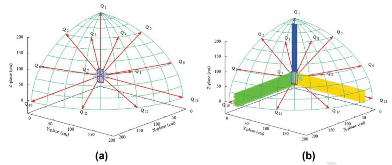A Directional Detector Response Function for Anisotropic Detectors
Abstract
For a radiation detector that is not isotropic, a directional detector response is needed to accurately account for the variation in a detector’s behavior depending on the incoming particle direction. The concept of the detector response function has been extended to include particle direction using a set of pregenerated detector responses based on the orientation of the incoming radiation and the detector. This directional detector response function (DDRF) then can be applied to the flux and current tallies computed by a Monte Carlo simulation. Validation of the new approach has been done by comparing simulated count rates processed with the DDRF to measured count rates taken with a 5.08 × 10.16 × 40.64-cm NaI(Tl) detector. The comparisons show that the applied method produces good agreement with both background and source measurements with a 137Cs source. Furthermore, separation of the detector response generation from Monte Carlo particle transport calculations provides greater flexibility in locating single or multiple detectors without any interference in the model and also enables simulation of various models using the same detector response without the need for generating additional detector responses if the same detector is being used.
- Authors:
-
- Oak Ridge National Lab. (ORNL), Oak Ridge, TN (United States)
- Publication Date:
- Research Org.:
- Oak Ridge National Lab. (ORNL), Oak Ridge, TN (United States)
- Sponsoring Org.:
- USDOE
- OSTI Identifier:
- 1545218
- Grant/Contract Number:
- AC05-00OR22725
- Resource Type:
- Accepted Manuscript
- Journal Name:
- Nuclear Science and Engineering
- Additional Journal Information:
- Journal Volume: 193; Journal Issue: 12; Journal ID: ISSN 0029-5639
- Publisher:
- American Nuclear Society - Taylor & Francis
- Country of Publication:
- United States
- Language:
- English
- Subject:
- 73 NUCLEAR PHYSICS AND RADIATION PHYSICS; 46 INSTRUMENTATION RELATED TO NUCLEAR SCIENCE AND TECHNOLOGY; 42 ENGINEERING; 98 NUCLEAR DISARMAMENT, SAFEGUARDS, AND PHYSICAL PROTECTION
Citation Formats
Celik, Cihangir, Peplow, Douglas E., Davidson, Gregory G., and Swinney, Mathew W. A Directional Detector Response Function for Anisotropic Detectors. United States: N. p., 2019.
Web. doi:10.1080/00295639.2019.1631028.
Celik, Cihangir, Peplow, Douglas E., Davidson, Gregory G., & Swinney, Mathew W. A Directional Detector Response Function for Anisotropic Detectors. United States. https://doi.org/10.1080/00295639.2019.1631028
Celik, Cihangir, Peplow, Douglas E., Davidson, Gregory G., and Swinney, Mathew W. Fri .
"A Directional Detector Response Function for Anisotropic Detectors". United States. https://doi.org/10.1080/00295639.2019.1631028. https://www.osti.gov/servlets/purl/1545218.
@article{osti_1545218,
title = {A Directional Detector Response Function for Anisotropic Detectors},
author = {Celik, Cihangir and Peplow, Douglas E. and Davidson, Gregory G. and Swinney, Mathew W.},
abstractNote = {For a radiation detector that is not isotropic, a directional detector response is needed to accurately account for the variation in a detector’s behavior depending on the incoming particle direction. The concept of the detector response function has been extended to include particle direction using a set of pregenerated detector responses based on the orientation of the incoming radiation and the detector. This directional detector response function (DDRF) then can be applied to the flux and current tallies computed by a Monte Carlo simulation. Validation of the new approach has been done by comparing simulated count rates processed with the DDRF to measured count rates taken with a 5.08 × 10.16 × 40.64-cm NaI(Tl) detector. The comparisons show that the applied method produces good agreement with both background and source measurements with a 137Cs source. Furthermore, separation of the detector response generation from Monte Carlo particle transport calculations provides greater flexibility in locating single or multiple detectors without any interference in the model and also enables simulation of various models using the same detector response without the need for generating additional detector responses if the same detector is being used.},
doi = {10.1080/00295639.2019.1631028},
journal = {Nuclear Science and Engineering},
number = 12,
volume = 193,
place = {United States},
year = {Fri Jul 12 00:00:00 EDT 2019},
month = {Fri Jul 12 00:00:00 EDT 2019}
}
Figures / Tables:
 Fig. 1: Quadrature set used for DDRF database generation: (a) quadrature locations and (b) sampling with particles striking the detector along three quadrature directions—Q1, Q10, and Q13.
Fig. 1: Quadrature set used for DDRF database generation: (a) quadrature locations and (b) sampling with particles striking the detector along three quadrature directions—Q1, Q10, and Q13.
Works referenced in this record:
Response functions for sodium iodide scintillation detectors
journal, October 1972
- Berger, M. J.; Seltzer, S. M.
- Nuclear Instruments and Methods, Vol. 104, Issue 2
Monte Carlo Shielding Analysis Capabilities with MAVRIC
journal, May 2011
- Peplow, Douglas E.
- Nuclear Technology, Vol. 174, Issue 2
Initial MCNP6 Release Overview
journal, December 2012
- Goorley, T.; James, M.; Booth, T.
- Nuclear Technology, Vol. 180, Issue 3
A Methodology for Determining the Concentration of Naturally Occurring Radioactive Materials in an Urban Environment
journal, April 2018
- Swinney, Mathew W.; Peplow, Douglas E.; Patton, Bruce W.
- Nuclear Technology, Vol. 203, Issue 3
Multiagency Urban Search Experiment Detector and Algorithm Test Bed
journal, July 2017
- Nicholson, Andrew D.; Garishvili, Irakli; Peplow, Douglas E.
- IEEE Transactions on Nuclear Science, Vol. 64, Issue 7
A new Monte Carlo assisted approach to detector response functions
journal, January 2004
- Sood, Avneet; Gardner, Robin P.
- Nuclear Instruments and Methods in Physics Research Section B: Beam Interactions with Materials and Atoms, Vol. 213
Figures / Tables found in this record:

 Search WorldCat to find libraries that may hold this journal
Search WorldCat to find libraries that may hold this journal